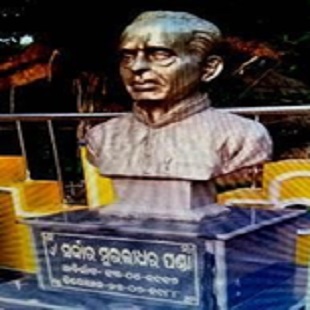
Muralidhar Panda was born on 13 April 1916 in Dhusuri in the Bhadrak district. His father’s name was Dinabandhu Panda. In 1941 he was a student at Mahatab Sanskrit college, Bardhaman where he already made a mark of himself by participating in revolutionary activities with a group of friends and spreading the activities in Bardhaman, Murshidabad, and Birbhum. When Harekrushna Mahtab came to know about him he requested him to come back to Bhadrak and lead the movement there which by 1941 had become a volcano of revolutionary activities. He, therefore, accepted the responsibility of involving more people from Dhushuri to Cuttack to assist him in his revolutionary activities. He held meetings in many places in the Dhamnagar area and was able to draw a large section of people to the movement with his passionate speeches. He inspired an educated young man of Dhamnagar Baishnab Charan Nayak to form a voluntary organization named ‘Rakta bahini’ which was prepared to indulge in any type of violence for the sake of the country. He led it to set fire to Bhandaripokhari police station on 17 August 1942. They also injured two police constables, set fire to some of the policemen’s houses, sabotaged telephone service, and blew up a wooden bridge on the grand trunk road. They did all these to disrupt communication to prevent the appearance of police. Police however came there later on and arrested a few revolutionaries who were sentenced to two years of imprisonment. Thereafter the group led by Muralidhar Panda decided to free Dhamnagar from the British yoke. On 20 September 1942, the police seized from Muralidhar Jena, a worker of Muralidhar Panda, a piece of paper containing an action plan of the capture of Bhadrak court on 25 September. This message was sent by Muralidhar Panda, to him. When the message was intercepted the police were alarmed and swung into action. British police officer Major Fox ordered to nab Muralidhar who was in Lunia village. When Murali was informed about the police witch-hunting, he, as a countermeasure, asked the nearby people to assemble there by blowing conch shells. As a result, 10,000 people rushed to the spot before the appearance of policemen. It was 22 September 1942. They outnumbered the policemen and snatched guns from them. Finding no way out, the policemen played a trick by stating that though they were serving under the British government to feed their stomach, they supported the freedom struggle. The people therefore returned their guns. But as soon as the policemen got back the guns they sprayed bullet on the people killing nine of them and injuring about one hundred. This bloodshed took place just six days before the firing in Eram on 28 September 1942, just a few kilometres away from the place. Thereafter the police arrested the main leaders. After the incident Nabakrushna Chaudhury named Lunia as Saheed nagar. The people of the area still observe 22 September as Saheed Day. Muralidhar Panda who died on 25 June 1988 was observing the day with the local people. Murali also since then was known as Sardar Muralidhar Panda for his organizing and leadership quality.
Source:
- Pattnaik, Jagannath, Odishare Bharat Chhada Andolanara Pratidwani, Bhadrak Pujya Puja Sansad, 2018
- Das, Rashmi Rekha, ‘Courage Under Fire’ , Orissa Post, 15 August, 2020.
- Sahoo, Nrusingha, Ame Odia, Vol III, Bhubaneswar, 2017